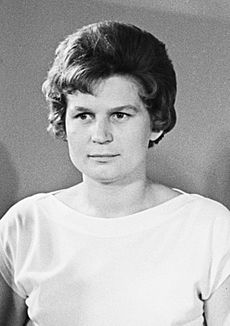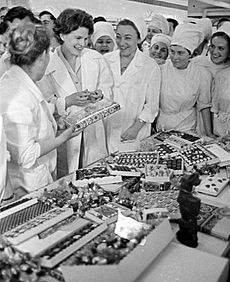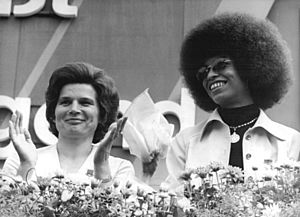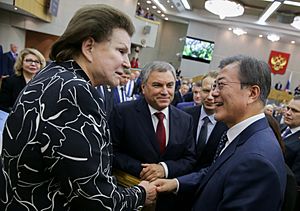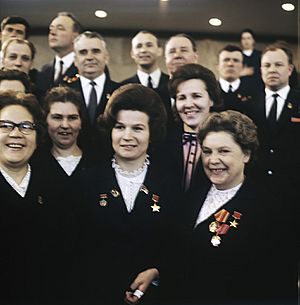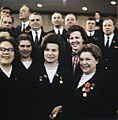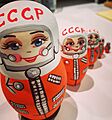Valentina Tereshkova facts for kids
Quick facts for kids
Valentina Tereshkova
|
|
|---|---|
| Валентина Терешкова | |
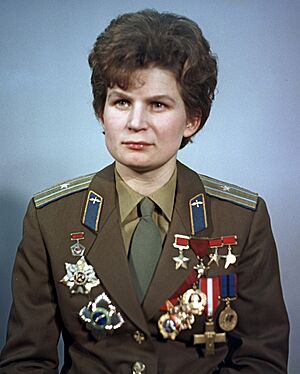
Tereshkova in 1963
|
|
| Member of the State Duma | |
| Assumed office 21 December 2011 |
|
| Personal details | |
| Born | 6 March 1937 Bolshoye Maslennikovo, Yaroslavl Oblast, Soviet Union |
| Political party |
|
| Spouses | |
| Children | 1 |
| Occupation |
|
| Awards | |
| Other names | Valentina Nikolayeva-Tereshkova |
| Space career | |
| Soviet cosmonaut | |
| Rank | Major general, Russian Air Force (1962–1997) |
|
Time in space
|
2 days, 22 hours, and 50 mins |
| Selection | 1st female group |
| Missions | Vostok 6 |
| Signature | |
 |
|
Valentina Vladimirovna Tereshkova (born 6 March 1937) is a Russian engineer, a member of the State Duma (like a parliament), and a former Soviet cosmonaut. She made history as the first woman in space. She flew a solo mission on Vostok 6 on 16 June 1963.
During her flight, she orbited Earth 48 times. She spent almost three days in space. Valentina is the only woman to have flown a space mission by herself. She is also the last living cosmonaut from the early Vostok programme. When she flew, she was 26 years old. This makes her the youngest woman to have flown into space.
Before becoming a cosmonaut, Tereshkova worked in a textile factory. She was also an amateur skydiver. She joined the Air Force as part of the Cosmonaut Corps. She became an officer after finishing her training. After the first group of female cosmonauts ended in 1969, Tereshkova stayed in the space program. She worked as a cosmonaut instructor. She later studied at the Zhukovsky Air Force Engineering Academy. She was approved to fly in space again, but she never did. She retired from the Air Force in 1997 as a major general.
Tereshkova was an important member of the Communist Party of the Soviet Union. She held many political jobs. She was part of the Presidium of the Supreme Soviet from 1974 to 1989. She continued to be active in politics after the collapse of the Soviet Union. She was elected to her regional parliament in 2008. In 2011, she was elected to the national State Duma. She is a member of the United Russia party. She was re-elected in 2016 and 2021.
In 2022, she voted for the Russian invasion of Ukraine. This led to some countries placing restrictions on her.
Contents
Early Life and Education
Valentina Tereshkova was born on 6 March 1937. She was born in Bolshoye Maslennikovo. This village is on the Volga River. It is about 270 kilometers (170 miles) northeast of Moscow. Her parents came from Belarus. Her father, Vladimir Tereshkov, was a tractor driver. He was also a sergeant in the Soviet Army. He died in the Finnish Winter War during World War II. Valentina was two years old at the time.
After her father's death, her mother moved the family to Yaroslavl. They hoped to find better jobs there. Her mother worked at a cotton mill.
Tereshkova started school when she was 10. She finished school at 17. She then worked at a tire factory. Later, she worked at a textile mill. She also continued her education through special courses. She graduated from the Light Industry Technical School in 1960.
Discovering Skydiving
From a young age, Tereshkova loved parachuting. She trained in skydiving at a local club. She made her first jump at age 22, on 21 May 1959. While still working at the textile mill, she trained as a competitive parachutist. She kept this a secret from her family. Tereshkova also joined the local Komsomol (Communist Youth League). She was a leader in the group in 1960 and 1961. She became a member of the Communist Party in 1962.
Becoming a Cosmonaut
Selection and Training for Space
Valentina Tereshkova had not planned to go to space. Her skydiving skills helped her get chosen as a cosmonaut. After Yuri Gagarin's flight in 1961, a director named Nikolai Kamanin learned that American women were training to be astronauts. He wrote in his diary, "We cannot allow that the first woman in space will be American."
So, the Soviet Union decided to train five female cosmonauts. They started training in 1963. To be chosen, a person had to be a parachutist. They also had to be under 30 years old. They needed to be less than 170 cm (5 ft 7 in) tall. Their weight could not be more than 70 kg (154 lb).
By January 1962, 400 people were considered. After checking, 58 met the rules. Kamanin narrowed it down to 23. On 16 February 1962, Tereshkova and four others were chosen. They joined the female cosmonaut team.
Since they had no military experience, they started as privates in the Soviet Air Forces. Their training was tough. It included isolation tests and centrifuge tests. They also had to train in MiG-15UTI jet fighters. Tereshkova also practiced landing in water. Motorboats made the water rough to simulate space conditions. She also began studying at the Zhukovsky Air Force Engineering Academy. She graduated a few years after her flight.
The group trained for several months. After passing their exams, they became officers. All five women became junior lieutenants in the Air Force in December 1962. Two women, Tatyana Kuznetsova and Zhanna Yorkina, were not chosen for the first flight. This left Tereshkova, Irina Solovyova, and Valentina Ponomaryova as the top choices.
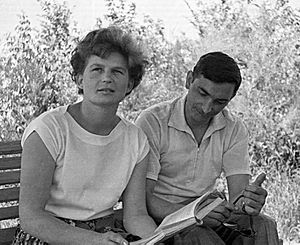
At first, the plan was to send two women into space. They would fly solo on different days in March or April 1963. Tereshkova would fly first in Vostok 5. Ponomaryova would follow in Vostok 6. But this plan changed in March 1963. Vostok 5 would now carry a male cosmonaut, Valery Bykovsky. A woman would fly aboard Vostok 6. Both would launch in June 1963.
On 21 May, Tereshkova was chosen to pilot Vostok 6. Kamanin called her "Gagarin in a skirt." Soviet Premier Nikita Khrushchev liked her selection. She was the daughter of a farm worker who died in the war. He approved her choice. Solovyova was her backup. Tereshkova was promoted to lieutenant before her flight. She became a captain during her flight.
The Historic Vostok 6 Flight
After Vostok 5 launched successfully on 14 June, Tereshkova got ready for her flight. On the morning of 16 June 1963, Tereshkova and her backup, Solovyova, put on their spacesuits. They were taken to the launch pad. After checks, she was sealed inside the Vostok capsule.
After a two-hour countdown, Vostok 6 launched perfectly. Valentina Tereshkova became the first woman in space. She is still the only woman to have flown into space alone. At 26, she was also the youngest. Her call sign during the flight was Chaika, meaning "Seagull." Later, an asteroid was named 1671 Chaika in her honor. After launching, she radioed:
It is I, Seagull! Everything is fine. I see the horizon; it's a sky blue with a dark strip. How beautiful the Earth is ... everything is going well.
Vostok 6 was the last Vostok flight. It launched two days after Vostok 5, which carried Bykovsky. The two spacecraft were in orbit for three days. At one point, they came within 5 kilometers (3 miles) of each other. They could talk by radio. Cameras inside both spacecraft sent live video to Soviet television. Tereshkova also kept a flight log. She took photos of the horizon. These photos helped scientists study layers in the atmosphere.
In this one flight, she spent more time in space than all American astronauts combined at that time. Her mission helped doctors study how space travel affects humans. It also gave information about how space affects women. Tereshkova felt sick and uncomfortable for much of the flight. But she orbited Earth 48 times. She spent 2 days, 22 hours, and 50 minutes in space.
As planned, Tereshkova ejected from her capsule during its return. This happened about 6.4 kilometers (4 miles) above Earth. She landed by parachute 620 kilometers (385 miles) northeast of Karaganda, Kazakhstan. This was at 8:20 am UTC on 19 June. Bykovsky landed three hours later.
Tereshkova later said she had trouble controlling her parachute. Strong winds made it difficult. But she landed safely. She got a bruise on her nose. Local villagers in the Altai Krai helped her out of her spacesuit. She then had dinner with them.
Life After Spaceflight
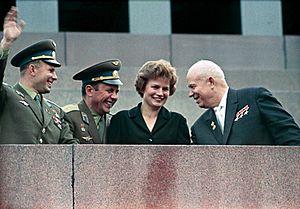
The Russian newspaper Pravda reported that a million flowers were used to celebrate the cosmonauts in Moscow. On 22 June 1963, Khrushchev greeted Bykovsky and Tereshkova. He announced that both were given the Hero of the Soviet Union medal. They all gave speeches from atop Lenin's Tomb in Red Square. Tereshkova said, "my father perished defending our country and my mother brought up her three children. We know the bitterness of that war. We don't need war." She was talking about the anniversary of the German invasion of Russia.
After her mission, she was asked how the Soviet Union could thank her. Tereshkova asked the government to find where her father was killed. They found the spot in Lemetti, Karelia. A monument was built there. On the evening of 22 June, Bykovsky and Tereshkova received the Order of Lenin at the Kremlin.
Less than a week after her flight, Moscow hosted the International Women's Congress. Tereshkova and Bykovsky were greeted by 2,000 women from 119 countries. Tereshkova received the most invitations to visit other countries. Her trips had to be approved by several government groups.
All the Vostok cosmonauts traveled a lot. Tereshkova traveled the most. She made 42 trips abroad between 1963 and 1970. In October 1963, she met Fidel Castro in Cuba. In February 1964, she visited Elizabeth II in the United Kingdom. Tereshkova was pregnant at the time. She went on a busy world tour, returning to her public duties only two months after her daughter was born.
After her spaceflight, Tereshkova became a role model. She received many letters and telegrams from around the world. Women were especially excited about her flight. For example, in New Delhi, Tereshkova was seen as a "feminist standard bearer."
Tereshkova was a well-known representative for the Soviet Union. She became a member of the World Peace Council in 1966. She was also a member of the Yaroslavl Soviet in 1967. She represented the Soviet Union at the UN Conference for the International Women's Year in 1975. She was interested in "socialist internationalism and women's roles in guaranteeing world peace."
Tereshkova also held several political jobs. She was a member of the Supreme Soviet of the Soviet Union (1966–1974). She was also a member of the Central Committee of the Communist Party (1969–1991). She was appointed vice president of the International Woman's Democratic Federation. She was also president of the Soviet-Algerian Friendship Society.
Tereshkova wanted to continue her career as a cosmonaut and engineer. But her leaders had other plans. After Gagarin's death, the Soviet space program did not want to risk losing another hero. Against her wishes, she was made the leader of the Committee for Soviet Women in 1968.
A few months after she graduated from the Zhukovsky Air Force Engineering Academy in October 1969, the team of women cosmonauts was ended. No woman went to space again until Svetlana Savitskaya in 1982. This was a gap of 19 years.
By 1976, Tereshkova was a colonel in the Soviet Air Forces. In April 1977, she earned a doctorate in aeronautical engineering. She passed medical tests to fly in space again. This was when a new group of women cosmonauts was announced in 1978. Although she did not go to space again, she remained an instructor at the Yuri Gagarin Cosmonaut Training Center.
Later Political Career
Valentina Tereshkova stayed active in politics after the Soviet Union broke apart. She ran for elections to the national State Duma in 1995 but did not win. In 1995, Tereshkova was given the honorary rank of major general. On 28 April 1997, she left the Russian Air Force. This was because she reached the age of mandatory retirement at 60.
In 2003, Tereshkova ran for a seat in the State Duma again. In 2007, she was invited to Prime Minister Vladimir Putin's home for her 70th birthday. There, she said she would like to fly to Mars, even if it was a one-way trip. She was later elected in 2008 to her regional parliament, the Yaroslavl Oblast Duma.
On 4 December 2011, Tereshkova was elected to the State Duma. This is the lower house of the Russian legislature. She represented the Yaroslavl Oblast and was a member of the United Russia party. In the 6th State Duma, she was part of a committee for protecting Christian values. She supported adding to the Constitution of Russia that "Orthodoxy is the basis of Russia's national and cultural identity." These ideas are different from her earlier atheist views during the Soviet era. At that time, she called religion "a big evil."
On 18 September 2016, Tereshkova was re-elected to the 7th State Duma. She serves as a deputy chairperson for a committee on government structure.
During the process of making changes to the 2020 amendments to the Constitution of Russia, she suggested removing term limits for President Putin.
Because of the Russian invasion of Ukraine, some countries placed restrictions on her. In September 2022, the United States added Tereshkova to a list that freezes her assets and stops U.S. people from dealing with her. In December 2022, the European Union also placed restrictions on her. This involves freezing her assets and banning her from entering EU countries.
Personal Life

Valentina married cosmonaut Andriyan Nikolayev on 3 November 1963. Their wedding was held at the Moscow Wedding Palace. Khrushchev led the wedding party. Soviet space leaders encouraged the marriage. They saw it as a "fairy-tale message to the country." General Kamanin, head of the space program, said it was "probably useful for politics and science."
On 8 June 1964, almost a year after her space flight, she gave birth to their daughter. Her name is Elena Andrianovna Nikolaeva-Tereshkova. She was the first person whose parents had both traveled into space.
Later, Valentina and Andriyan grew apart. Tereshkova said their marriage ended in 1977. They divorced in 1982. Tereshkova then married Yuli Shaposhnikov. He was a surgeon she met during her medical exams to become a cosmonaut again. They were married until Shaposhnikov's death in 1999.
Awards and Honours
Russian Awards
- Order of Merit for the Fatherland:
- 3rd class (1997)
- 2nd class (2007)
- 1st class (2017)
- Order of Alexander Nevsky (2013)
- Order of Honour (2003)
- Order of Friendship (2011)
- Russian Federation State Prize (2009)
- Participant of the Military Operation in Syria Medal (2016)
- Order of Gagarin (2023)
- Strengthening the Military Community Medal (2018)
- Certificates of appreciation from the Government of the Russian Federation (1997, 2003, 2008)
- Order of St. Euphrosyne of Moscow (2008)
Soviet Awards
- Merited Master of Sports of the Soviet Union (1963)
- Hero of the Soviet Union (1963)
- Order of Lenin (1963, 1981)
- Order of the October Revolution (1971)
- Order of the Red Banner of Labour (1987)
- Order of the Friendship of Peoples
- Pilot-Cosmonaut of the Soviet Union (1963)
Other Awards and Honours
- Gold star Hero of Socialist Labor (Czechoslovakia, 1963)
- Gold star Hero of Socialist Labor (Bulgaria, 1963)
- Order of Georgi Dimitrov (Bulgaria, 1963)
- Order of Karl Marx (East Germany, 1963)
- Artur Becker Medal (East Germany, 1963)
- Cross of Grunwald, 1st class (Poland, 1963)
- Order of the Flag of the Republic of Hungary, 1st class (1965)
- Star of the Republic of Indonesia, 2nd class (1963)
- Order of the Volta (Ghana, 1964)
- Gold Star Medal of the Hero of the Mongolian People's Republic (1965)
- Order of Sukhbaatar (Mongolia, 1965)
- Order of the Enlightenment (Afghanistan, 1969)
- Order of Planets (Jordan, 1969)
- Order of the Nile (Egypt, 1971)
- Gold Star of Hero of Labor (Vietnam, 1971)
- Order of Bernardo O'Higgins (Chile, 1972)
- Order of Ana Betancourt (Cuba, 1974)
- Order of Friendship (Laos, 1997)
- Order of Duke Branimir, with sash (Croatia, 2005)
- Eduard Rhein Ring of Honor (Germany, 2007)
- Gold Medal of the British Society for interplanetary communications (1964)
- Gold Space Medal (FAI, 1963)
- Honorary doctorate from the University of Edinburgh (1990)
Legacy and Recognition
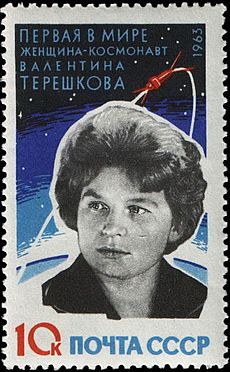

A square in Tver was renamed Tereshkova Square in 1963.
In 1967, Gregory Postnikov made a sculpture of Tereshkova. It is in Cosmonaut Alley in Moscow. There is also a monument near her landing place in Siberia. In August 1970, a lunar crater on the far side of the Moon was named Tereshkova crater after her.
None of the other four women in Tereshkova's early group flew into space. In October 1969, the female cosmonaut group was closed. Even though there were plans for more women to fly, it took 19 years until the second woman, Svetlana Savitskaya, went to space.
Many songs and films have been made about Valentina Tereshkova. In 1997, the group Komputer released a song called "Valentina." The 2000 album Vostok 6 by Kurt Swinghammer is about her. The 2015 album The Race for Space by Public Service Broadcasting also has a song called "Valentina." In the same year, Findlay Napier's album VIP: Very Interesting Persons included a song "Valentina." In 2015, a short film called Valentina's Dream was released. It stars Rebecca Front as Tereshkova. The film is based on her wish to journey to Mars.
The Cosmos Museum opened in 1975 near Yaroslavl. It has a copy of her childhood home. The city library was named after her in 2013. The school she went to as a child was also renamed for her. A planetarium in Yaroslavl was built and named for her in 2011. The International Women of the Year association called her the "greatest woman achiever of the 20th century." Tereshkova was a torchbearer for the 2008 Summer Olympics torch relay in Saint Petersburg. She also carried the torch for the 2014 Winter Olympics torch relay in Sochi.
Images for kids
See also
 In Spanish: Valentina Tereshkova para niños
In Spanish: Valentina Tereshkova para niños
- List of female spacefarers
- List of female Heroes of the Soviet Union


